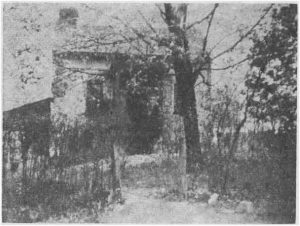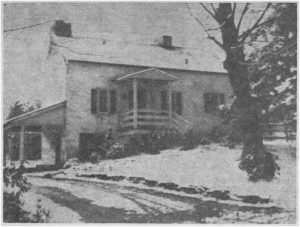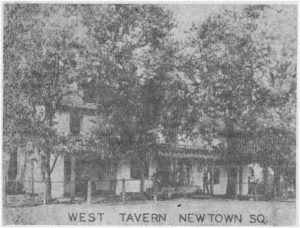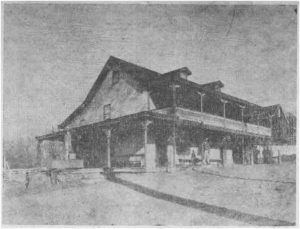On Wednesday morning, April 15, a group of women filled to overflowing the spacious living room in Mrs. Howard C. Petersen’s home in Radnor, for the 1953 annual meeting of the League of Women Voters of Radnor Township.
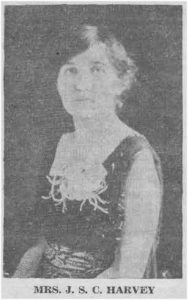 Seated in the midst of this large group of representative women of Radnor township was the woman to whom, more than any other, the local League of Women Voters owes its organization. For it was Mrs. J.S.C. Harvey, of Radnor, who, on August 23, 1920, held an informal meeting, at her home, of a group then known as the Radnor Township League of Women Citizens, of which she was chairman.
Seated in the midst of this large group of representative women of Radnor township was the woman to whom, more than any other, the local League of Women Voters owes its organization. For it was Mrs. J.S.C. Harvey, of Radnor, who, on August 23, 1920, held an informal meeting, at her home, of a group then known as the Radnor Township League of Women Citizens, of which she was chairman.
Before the other nine women had left Mrs. Harvey’s home this name had been changed to that of the League of Women Voters of Radnor Township, one of the first small units to be formed in the United States of the National League of Women Voters.
The minutes of this first meeting state that “in changing the name and purpose of the organization… all felt a great and new responsibility, and faced it in a two-hour discussion on how best to meet this responsibility.”
Besides Mrs. Harvey, there were present at this organizational meeting Mrs. F.F. Hallowell, Miss Nancy Hallowell, Mrs. Allyne Martin, Mrs. John Kent Kane and Miss Helen Torpey – all members of the women’s suffrage organization – and Mrs. David Paul Brown, Mrs. F.A. Gugert, Dr. Marianna Taylor and Miss Mary L. Walsh as “new recruits to the cause.”
It was only three days before this meeting that national suffrage for the women had been won by the ratification of the 19th Amendment to the United States Constitution by 36 states, the required number to make the amendment legal. It was three days after this small local meeting that, on August 26, 1920, Secretary of State Colby signed the Suffrage Proclamation, making valid the 19th amendment. This Proclamation reads as follows:
“The right of citizens of the United States to vote shall not be denied or abridged by the United States or any state on account of sex.
“Congress shall have power to enforce this Article by appropriate legislation.”
The first convention of the National League of Women Voters was held in Chicago in February, 1920. This national organization’s first president was Mrs. Maud Wood Park, a woman experienced in working for the passage of legislation. Almost a year before this in the spring of 1919 Carrie Chapman Catt, speaking to the leaders of the National Women’s Suffrage Association, had proposed “a League of Women Voters to finish the fight and to aid in the reconstruction of the nation.” The “fight” to which she referred was the struggle then almost won for national woman suffrage, while the “reconstruction of the nation” was that of the country’s need in a critical post-war period.
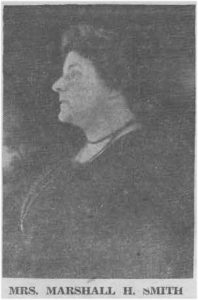 During more than 50 years, women connected with the movement had worked slowly but surely towards obtaining the right to vote in individual states. In some few of these states there had been suffrage for many years. And now, at last, a Constitutional amendment would make national suffrage a reality.
During more than 50 years, women connected with the movement had worked slowly but surely towards obtaining the right to vote in individual states. In some few of these states there had been suffrage for many years. And now, at last, a Constitutional amendment would make national suffrage a reality.
Those who, like Mrs. Catt and Mrs. Park, had labored long and against odds for this privilege, resolved to make the best possible use of it. And with this objective they pledged a new League of Women Voters as a “living memorial” to all who had helped to bring it about.
They set themselves three particular objectives: First that they would strive to educate themselves, the 20,000,000 new voters. Second, they would work for “needed legislation” and third, they would strive to arouse as many citizens as possible to participate in government.
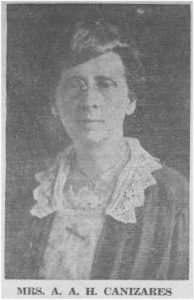 The founding members of the League soon found, however, that their dream was too great a one to be realized very soon. To quote Kathryn H. Stone’s brochure, “25 Years of a Great Idea”, published in 1946, “20,000,000 women did not leap to the polls. Many displayed an aggravating lack of appreciation of the right which the League afforded them.” However, a small number of women, going about a great task, accomplished a surprizing amount. In the way of organization State Leaguers soon became the keystone of the League structure. These State Leagues selected a program and chose national officers. Members of the National Board “carried the enthusiasm and inspiration for the whole League to the smallest and most remote towns.”
The founding members of the League soon found, however, that their dream was too great a one to be realized very soon. To quote Kathryn H. Stone’s brochure, “25 Years of a Great Idea”, published in 1946, “20,000,000 women did not leap to the polls. Many displayed an aggravating lack of appreciation of the right which the League afforded them.” However, a small number of women, going about a great task, accomplished a surprizing amount. In the way of organization State Leaguers soon became the keystone of the League structure. These State Leagues selected a program and chose national officers. Members of the National Board “carried the enthusiasm and inspiration for the whole League to the smallest and most remote towns.”
Possibly Radnor township did not need this pressure from without to start its women to thinking and planning along League lines. Its inspiration apparently came from within, from such women as Mrs. Harvey and others who already had their “League of Women Citizens.” At any rate the date of their organization as a League of Women Voters follows very closely on that of the organization of the National group.
At their first meeting, held in August, 1920, they decided “to hold a general meeting as soon as possible to start an educational campaign, and to try to develop citizenship training classes thereafter.” Their immediate task as they saw it was that of assisting the assessors in registering women for the fall election. And with this in view, leaders for the different precincts were tentatively chosen for this work.
Other recruits soon joined the original ten. In the beginning Mrs. Harvey was the chairman, and other officers were chosen “protem.” The first regularly elected treasurer seems to have been Mrs. Marshall H. Smith, and the first recording secretary, Mrs. A.A.H. Canizares.
Through a happy coincidence, pictures of these three women taken during the first year of their term of office have been made available for use in today’s column. In 1921 Phillips and Phillips, prominent photographers of Philadelphia, assembled an album of pictures of such members of the Saturday Club as wished to have them taken. Among them are the three shown today, reproduced through the coutesy of the Saturday Club.
(to be continued)
(Since the publication of last weeks’ column on the precious stones and minerals found near Valley Forge, your columnist has had telephone calls from several people who gave additional imnformation. Mrs. Patterson will be glad to hear from others, as she plans a follow-up on the original article in the near future. The telephone number is Wayne 4569.)

